Oct 14, 2024
What Are The Content Pillars and Why Are They Important?
Content pillars are the fundamental topics or themes that drive your content strategy. They help ensure your content remains cohesive and relevant to your audience while aligning with your business goals. Think of them as the "backbone" of your content marketing efforts, guiding what you create across different channels like blogs, social media, and email campaigns.
A solid content pillar strategy saves time, reduces guesswork, and allows you to cover core themes thoroughly, ensuring consistency across the board.
For example, a digital marketing institute might have pillars like "SEO Techniques," "Social Media Marketing," and " Rise of AI in Content Creation."
Each pillar would then encompass related content such as blog posts, videos, and infographics, all tying back to that primary theme.
But why are they so critical and what are their types?
Let’s dive into the details and discover how content pillars can elevate your content game.
Types of Content Pillars

There are various types of content pillars that serve different purposes.
Let’s break them down:
- Evergreen Pillars: These are timeless topics that remain relevant over the years, such as “how-to” guides, fundamental industry tips, or best practices.
- Campaign-Specific Pillars: Short-term, focused on seasonal or promotional events. For example, content around a product launch or holiday sale.
- Product-Focused Pillars: Content that highlights features, benefits, and unique aspects of your product or service, driving home the value proposition.
- Audience-Based Pillars: Tailored specifically to different audience segments. This could include beginner guides vs. advanced tips, ensuring that each audience segment gets personalized content.
- Thought Leadership Pillars: These establish your brand as an authority by offering expert opinions, industry insights, or forecasts. This positions your brand as a leader in the field.
- Educational Pillars: Focus on teaching your audience something new, from tutorials to step-by-step guides, offering practical advice to help them solve a problem.
- Trends and News-Based Pillars: These keep your content fresh by focusing on current trends like how AI is changing digital marketing or timely industry news.
By combining several types of pillars, you can create a versatile and well-rounded content strategy that speaks to multiple audience needs.
Now, let us have a look at their importance in content strategy.
Why Are Content Pillars Important?
Content pillars provide clarity and direction to your content strategy.
Instead of constantly brainstorming new ideas, you have defined themes that serve as a consistent guide for everything you create. This helps maintain a clear brand message, no matter where your content appears—whether on your blog, social media, maximizing your PPC strategy, or email newsletters.

Here are a few key reasons why content pillars are crucial:
- Consistency: You’ll stay on message across all platforms, reinforcing your brand’s voice.
- SEO Benefits: By building out in-depth content around central topics, search engines recognize you as an authority in those areas, leading to better rankings.
- Time Efficiency: With defined pillars, you spend less time ideating and more time executing high-quality content..
Now, you might be wondering how one can create effective content pillars.
Let us have a look at it.
How to Create Effective Content Pillars?
Creating effective content pillars involves a systematic process that aligns with your audience's interests and your business goals.
Here’s how to get started:
- Step 1: Understand Your Audience
Conduct surveys, analyze customer feedback, and use social media insights to discover what your audience is most interested in. What are their pain points? What information are they actively searching for? - Step 2: Define Core Themes
Based on your audience's needs and your brand’s strengths, identify 3-5 core themes. These will be your main content pillars. Ensure these are broad enough to allow for diverse subtopics but specific enough to keep your content focused. - Step 3: Plan Your Content Types
Decide which content formats work best under each pillar. Will it be blog posts, video tutorials, podcasts, or infographics? A mix of formats can keep your content engaging. - Step 4: Content Mapping
Map out subtopics for each pillar to ensure variety. Create a content calendar that allows you to tackle each pillar regularly, ensuring you don't neglect any key themes. - Step 5: Measure & Adjust
Regularly monitor the performance of your pillar content. Use metrics like engagement, traffic, and conversions to determine what’s working and tweak your pillars accordingly.
Want to know the connection between content pillars and SEO?
Let's dive into it.
Content Pillars and SEO

Content pillars are your secret weapon for SEO success. When you organize content around specific themes, search engines recognize your site as an authority on those topics, leading to higher rankings.
Here’s how content pillars boost SEO:
- Topic Authority: By creating deep, valuable content around a central theme, search engines view you as a go-to resource for that topic.
- Internal Linking: Pillar content acts as a hub for related articles, improving your internal linking structure, which search engines love.
- Improved User Experience: Well-structured content pillars make it easier for visitors to find relevant content, reducing bounce rates and keeping them engaged longer.
By creating content around focused themes, you also increase your chances of ranking for long-tail keywords, which often have lower competition but drive higher-quality traffic.
However, it's important to avoid common pitfalls when building content pillars to ensure maximum impact. Let’s dive into the Common Mistakes to Avoid When Building Content Pillars next.
Common Mistakes to Avoid When Building Content Pillars
There are several pitfalls to avoid when creating content pillars.
Here are the most common mistakes:
- Too Broad Themes: If your content pillars are too general, your content will lack focus, making it hard to engage your audience. Narrow your themes for clarity.
- Skipping Audience Research: Without understanding your audience, your pillars won’t resonate. Audience research ensures your pillars align with what your audience wants.
- Inconsistent Posting: Infrequent content creation dilutes the impact of your pillars. Consistency is key to building a loyal audience.
- Ignoring SEO: Without optimizing your pillar content for search engines, you’ll miss out on valuable traffic. Ensure your content is SEO-friendly with proper keywords, internal links, and optimized metadata.
Now, let us wrap it up.
Final Thoughts
Content pillars are the cornerstone of a successful content strategy. They keep your messaging consistent, improve SEO, and make your content planning easier.
By understanding your audience, defining clear themes, and avoiding common mistakes, you can create a content strategy that drives engagement and delivers results.
Start building your content pillars today to ensure your brand stays focused, consistent, and relevant in an ever-changing digital landscape.